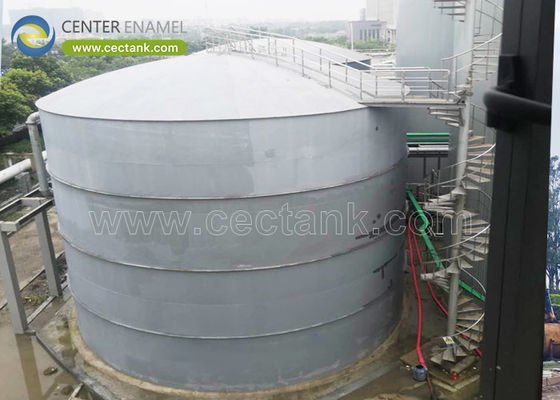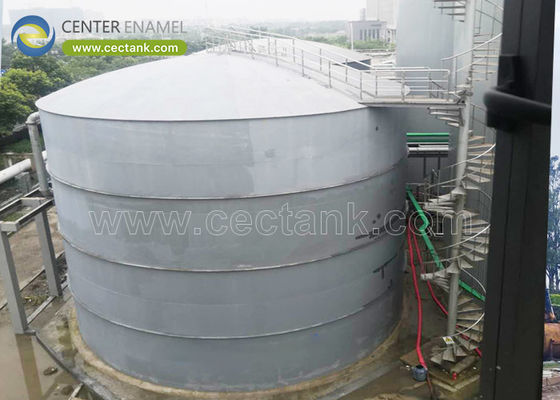-
Glass Fused To Steel Tanks (419)
-
Stainless Steel Tanks (410)
-
Fusion Bonded Epoxy Tanks (424)
-
Galvanized Steel Tanks (321)
-
Aluminum Dome Roofs (872)
-
Wastewater Storage Tanks (226)
-
Welded Steel Tanks (297)
-
Pressure Vessels (295)
-
Anaerobic Digester (201)
-
Industrial Water Tanks (349)
-
Glass Lined Steel Tanks (180)
-
Bolted Steel Tanks (181)
-
Sludge Storage Tank (115)
-
Biogas Storage Tank (173)
-
Leachate Storage Tanks (133)
-
Agricultural Water Storage Tanks (179)
-
Fire Water Tank (166)
-
Grain Storage Silos (130)
-
Biogas Projects (349)
-
Wastewater Treatment Projects (270)
-
Double Membrane Roof (223)
China Welded Stainless Steel Tank Manufacturer: Center Enamel’s Benchmark for Hygienic, Durable Vessels
| Place of Origin: | China |
| Brand Name: | CEC TANKS |
| Certification: | ISO 9001:2008, AWWA D103 , OSHA , BSCI |
| Model Number: | W |
| Minimum Order Quantity: | 1set |
| Price: | $5000~$20000 one set |
| Packaging Details: | PE poly-foam between each two steel plates ; wooden pallet and wooden |
| Delivery Time: | 10-30 days after deposit received |
| Payment Terms: | L/C, T/T |
| Supply Ability: | 60 sets per month |
|
Detail Information |
|||
| Place of Origin | China | Brand Name | CEC TANKS |
|---|---|---|---|
| Certification | ISO 9001:2008, AWWA D103 , OSHA , BSCI | Model Number | W |
| Corrosion Resistance: | Suitable For Waste Water Salt Water, Sea Water, High Sulfur Crude Oil, Salt Fox, Organic And Inorganic Compounds | Elastic: | Same As Steel Sheet |
| Tank Body Color: | Customized Design | Coating Thickness: | Customized |
| Foundation: | Concrete | Steel Grade: | Stainless Steel |
| Highlight: | welded stainless steel tank,hygienic welded steel vessel,durable stainless steel storage tank |
||
Product Description
China Welded Stainless Steel Tank Manufacturer: Center Enamel’s Benchmark for Hygienic, Durable Vessels
As the global marketing writer for Shijiazhuang Zhengzhong Technology Co., Ltd (Center Enamel), I present an in-depth article highlighting China’s welded stainless steel tank manufacturing landscape and Center Enamel’s leadership within it. This piece covers market context, our capabilities, design and production processes, material science, quality assurance, industry applications, and future directions. It is crafted to inform international buyers, distributors, and partners seeking high-performance, compliant, and cost-efficient stainless steel tanks.
The value proposition of welded stainless steel tanks
Welded stainless steel tanks are essential equipment across food and beverage, dairy, pharmaceutical, cosmetics, chemical processing, brewing, and municipal sectors. The welded construction delivers seamless interiors, robust structural integrity, and reliable leak resistance. When paired with hygienic finishes, CIP/SIP compatibility, and validated cleaning procedures, welded tanks support consistent product quality, regulatory compliance, and efficient operations. Center Enamel’s welded stainless steel tanks are engineered to meet stringent performance targets, from sanitary design and traceability to corrosion resistance and energy efficiency.
Market context: China as a global manufacturing hub
- Scale and capabilities: China remains a premier destination for precision fabrication, metal forming, and sanitary equipment production. A dynamic ecosystem of raw material suppliers, welding specialists, surface finishers, and quality assurance providers underpins competitive lead times and scalable capacity.
- Value proposition: competitive pricing, aggressive investment in automation and quality management, and access to a broad range of stainless steel grades enable Center Enamel to deliver high-quality tanks at attractive total cost of ownership.
- Compliance and standards: Chinese manufacturers increasingly align with international standards and certifications (ISO 9001, CE, FDA-compliant processes where applicable) to support global sales and export.
- Local advantages: centralized logistics, integrated supply chains, and a culture of continuous improvement help Center Enamel respond quickly to customer needs and project schedules.
Center Enamel: capabilities and differentiators
- Custom design and engineering: We translate customer process requirements into detailed 3D models, material specifications, and fabrication plans. Our team collaborates with clients to optimize tank geometry, agitation, heat transfer, and cleaning interfaces.
- Material expertise: Our selection spans 304, 316, and their low-carbon variants (304L, 316L) to balance corrosion resistance, weldability, and cost. We prioritize hygienic interior finishes (Ra ≤ 0.8 μm where required) and passivation to enhance corrosion resistance at welds.
- Sanitary design: We emphasize cleanability, minimal dead zones, rounded corners, smooth weld transitions, and compatible sanitary fittings (Tri-Clamp, butt-weld, gaskets) to support CIP/SIP.
- Manufacturing excellence: Our fabrication integrates precise cutting, forming, welding, surface finishing, and assembly under a robust quality assurance framework. We employ non-destructive testing, leak testing, and dimensional verification to ensure performance and reliability.
- Quality assurance and traceability: A rigorous QA/QC program ensures traceability of materials, welding procedures, heat treatments, and final testing results, meeting international expectations.
- Global service mindset: We provide customized packaging, installation support, commissioning guidance, and after-sales service to support international projects across continents.
Materials and finishes: selecting the right combination
- Stainless steel grades:
- 304: good general corrosion resistance, strong formability, cost-effective for many processes.
- 316: superior resistance to chlorides and aggressive cleaning environments, preferred for dairy, pharmaceutical, and cosmetics with sanitize cycles and saline exposure.
- 304L/316L: low carbon variants offering reduced sensitization risk in welded tanks and better weld performance for thicker walls.
- Interior finishes:
- Mirror-polished finishes (often 316L) for maximum cleanability and sanitary requirements.
- Ground finishes where highly polished surfaces are not essential, balancing cost and cleanability needs.
- Surface protection and coatings:
- Passivation is routinely applied post-welding to enhance corrosion resistance.
- Exterior coatings or protective finishes may be used for enhanced aesthetics or corrosion protection in aggressive environments.
- Insulation and heat transfer:
- Jackets and coils support precise temperature control for fermentation, storage, or reaction processes, with insulation options tailored to energy efficiency and cleaning requirements.
Tank configurations and design considerations
- Geometry:
- Cylindrical shells with flat or dished ends are standard for storage and processing.
- Conical or torispherical bottoms aid drainage and CIP effectiveness; cone angle and height depend on product viscosity and cleaning cycles.
- End connections and ports:
- Inlets/outlets, sampling ports, vents, manways, and instrumentation penetrations are positioned for optimal flow, sanitation, and accessibility.
- Sanitary fittings (Tri-Clamp, sanitary welds) minimize crevices and simplify cleaning.
- Agitation and mixing:
- Options include top-enter, bottom-entry, magnetic drive, or variable-speed agitators, selected based on product viscosity, oxygen sensitivity, and cleaning compatibility.
- Baffles and stiffeners optimize mixing efficiency and reduce vortex formation.
- Heat transfer and temperature control:
- Internal coils or external jackets enable precise temperature management for fermentation, storage, or chemical processing.
- Thermal design accounts for heat transfer coefficients, product properties, and CIP/SIP access.
- Sanitation and hygienic design:
- Emphasis on smooth welds, rounded internal corners, and unobstructed clean zones to minimize microbial harborage.
- CIP readiness, including nozzle placement and drain geometry, is a core design criterion.
- Regulatory compliance:
- ISO 9001, FDA, 3-A Sanitary Standards, and EHEDG guidelines may apply depending on end-use and market.
Manufacturing process: from concept to commissioning
- Engineering and specification:
- Customer process parameters drive tank size, diameter, wall thickness, head shape, and ancillary equipment. Our engineers deliver CAD models, BOMs, and fabrication plans.
- Material preparation and cutting:
- Stainless steel plates are cut with precision, ensuring clean edges and minimal distortion.
- Forming and shaping:
- Shells and heads are formed through rolling, bending, or spinning processes to tight tolerances.
- Welding and seam integrity:
- Butt and fillet welds are performed using qualified procedures; welds are inspected via visual, dye penetrant, or radiographic methods as required.
- Surface finishing:
- Interiors are ground and polished to achieve hygienic finishes; passivation removes residual showings and enhances corrosion resistance at welds.
- Assembly and integration:
- Tanks are assembled with sanitary gaskets, flanges, and fittings designed for CIP/SIP compatibility.
- Testing and quality assurance:
- Hydrostatic or pneumatic pressure tests verify containment; cleaning verification ensures CIP readiness; dimensional checks confirm conforming geometry.
- Packaging and logistics:
- Tanks are packaged for safe delivery, with installation instructions and commissioning guidelines.
Global industry applications
- Food and beverage:
- Storage, fermentation, blending, and maturation vessels designed for cleanability and precise temperature control.
- Dairy:
- Sanitary tanks optimized for CIP/SIP and dairy-specific cleaning agents, with corrosion resistance and hygiene-centric finishes.
- Pharmaceuticals and biotech:
- Cleanroom-compatible tanks with validated cleaning procedures, stringent QA, and traceable manufacturing history.
- Cosmetics and personal care:
- Batch processing tanks with flexible configurations and high-quality finishes to ensure product purity.
- Chemicals:
- Corrosion-resistant tanks designed to handle aggressive chemicals, with coatings or alloys tailored to chemical resistance requirements.
- Brewing and distilling:
- Fermentation and maturation tanks with agitation and temperature control supporting flavor development and process reliability.
Operational benefits and lifecycle considerations
- Hygiene and safety:
- Welded interiors and seamless junctions reduce contamination risk and simplify compliance with food, pharmaceutical, and cosmetic standards.
- Reliability and uptime:
- Structural integrity of welded joints minimizes leakage risks and maintenance downtime.
- Cleanability and sanitation:
- CIP-friendly design reduces cycle times, water usage, and chemical consumption while ensuring repeatable sanitization.
- Longevity and resale value:
- Stainless steel’s corrosion resistance and market demand for hygienic equipment preserve value over decades.
- Total cost of ownership:
- While upfront costs may be higher, long-term savings from efficiency, quality, and reliability yield compelling ROI.
Installation, commissioning, and service
- Site mobilization and installation planning:
- We coordinate with clients to align tank placement with piping, cleaning systems, and maintenance access.
- Commissioning and validation:
- For regulated sectors, IQ/OQ/PQ documentation demonstrates installation, operation, and performance compliance.
- CIP/SIP readiness:
- Integrated spray devices, drains, and clean-out ports support validated cleaning cycles.
- Maintenance planning:
- Regular inspections and a spare parts strategy minimize downtime and extend tank life.
- After-sales support:
- Global service teams provide ongoing maintenance, field support, and replacement parts.
Quality assurance, standards, and certifications
- Material and process certifications:
- Documentation for stainless steel grades, surface finishes, coatings, and welding procedures accompanies each tank.
- Manufacturing quality:
- A formal QA/QC program ensures traceability and compliance with client specifications and international standards.
- Third-party verification:
- Independent inspections validate conformity, strengthening buyer confidence in global procurement.
- Compliance alignment:
- We align with relevant regional standards to facilitate export and international distribution.
Sustainability and environmental considerations
- Recyclability and lifecycle:
- Stainless steel is highly recyclable; design for disassembly supports end-of-life recycling.
- Clean production:
- Efficient CIP systems and reduced chemical usage contribute to sustainability goals.
- Energy efficiency:
- Insulation and heat transfer optimization minimize energy consumption in heating or cooling cycles.
Future directions and innovations
- Digitalization and remote monitoring:
- Sensor networks and digital twins enable predictive maintenance and data-driven optimization.
- Advanced surface science:
- Next-generation coatings and surface finishes promise easier cleaning, lower contamination risk, and longer service life.
- Modular and standardized platforms:
- Plug-and-play tank modules accelerate customization and scale-ups while reducing lead times.
- Sustainability-driven design:
- Material optimization, recycled-content stainless steel, and greener finishing processes will shape future tank development.
China’s welded stainless steel tank manufacturing ecosystem, led by Center Enamel, offers global customers high-quality, hygienic, and reliable vessels at competitive prices. Our comprehensive capabilities—from precise engineering and superior welding to rigorous quality assurance and responsive service—position Center Enamel as a trusted partner for international projects across food, dairy, pharmaceutical, cosmetics, chemical, brewing, and municipal sectors. By combining material science, advanced fabrication, and a customer-centric mindset, we deliver tanks that meet exacting sanitary standards, regulatory expectations, and lifecycle value.




